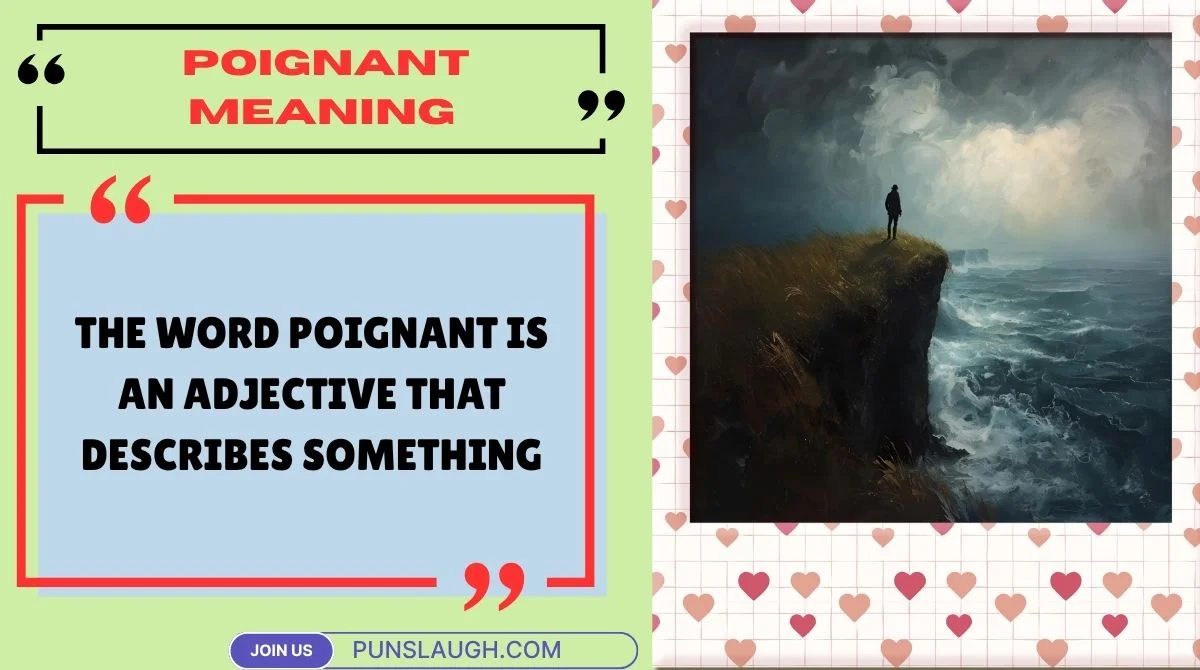Understanding “poignant meaning” opens a window into how language carries emotions.
The word isn’t just a fancy term for “sad.” It’s far richer. From literature to social media, it often captures the kind of feeling that lingers in your heart.
This guide explains the definition of poignant, traces its history, explores how it’s used in everyday speech and culture, and shows how you can use it correctly to express profound emotions.
What Does “Poignant” Really Mean?
The word poignant is an adjective that describes something that deeply moves your emotions — often in a way that’s bittersweet or piercing.
Definition:
Poignant means something that evokes a strong feeling of sadness, nostalgia, or tenderness, often mixed with beauty or significance.
Pronunciation:POY-nyənt (rhymes with “join-yunt,” though the “g” is silent in most accents)
Here’s how dictionaries typically phrase it:
- Cambridge Dictionary: “Causing or having a very sharp feeling of sadness.”
- Merriam-Webster: “Pungently pervasive, deeply affecting the feelings, designed to make an impression.”
In short, if something strikes a deep emotional chord, it’s poignant.
Historical Background of Poignant
The etymology of poignant is as fascinating as the feeling it describes.
- Originates from the Latin word “pungere”, meaning to prick or sting.
- Entered English via Old French “poindre”, carrying the sense of something sharp or piercing.
- Initially referred to physical sensations of sharp pain. Over time, it evolved to describe emotional sharpness — feelings that pierce the heart.
Timeline of Evolution
| Century | Usage Focus | Example |
|---|---|---|
| 14th Century | Physical sharpness (like pungent smells or stings) | “A poignant odor filled the hall.” |
| 17th Century | Blending physical and emotional pain | “A poignant loss of comrades.” |
| 19th Century | Primarily emotional, often bittersweet | “A poignant memory of childhood.” |
| Modern Usage | Deep emotional impact, especially in storytelling | “The movie’s ending was truly poignant.” |
This shift from physical pain to emotional depth highlights how language evolves alongside human experience.
Usage of Poignant in Everyday Language
The word appears in many contexts where something moves people emotionally.
Common Scenarios:
- Poignant memories: Moments that make you smile and tear up at the same time.
- Poignant speeches: Words that stir emotions, often during farewells or memorials.
- Poignant scenes: Moments in movies, plays, or even daily life that hit the heart.
Examples in Sentences:
- “Her story of growing up in poverty was poignant and inspiring.”
- “They shared a poignant goodbye at the train station.”
- “The photo of the soldier returning home was a poignant reminder of sacrifice.”
👉 Key Tip: Poignant doesn’t just mean “sad.” It’s about emotional sharpness — the moment feels so significant that it stings the heart.
Poignant in Literature, Media & Pop Culture
Writers and filmmakers often rely on “poignant” to describe moments that give their stories emotional depth.
In Literature
- Charles Dickens often created poignant scenes around social injustices.
- In poetry, poignant lines often capture fleeting, bittersweet beauty — think of Robert Frost’s “Nothing Gold Can Stay.”
In Film & TV
- The final scene of Titanic, where the Rose drops the necklace into the ocean, is poignant because it embodies both loss and closure.
- Schindler’s List has several poignant moments that highlight human suffering and hope.
In Pop Culture
- Tributes to celebrities after their passing often feature poignant montages.
- Social media posts about personal milestones — like a child’s first school day — can be described as poignant.
Regional and Cultural Variations
Though universally understood in English, regional nuance can slightly alter its tone.
| Region | Common Interpretation | Example |
|---|---|---|
| United States | Often tied to personal stories or memories | “A poignant moment at the family reunion.” |
| United Kingdom | Frequently used in literary and journalistic contexts | “The poignant end of the political leader’s tenure.” |
| South Asia & Africa | Can reflect community struggles or collective memories | “A poignant reminder of cultural heritage.” |
In some cultures, poignant moments are tied closely to communal experiences, while in others, they focus on personal reflection.
Similar Words and How They Differ
People often use words like “touching” or “moving” as synonyms for “poignant,” but each carries subtle differences.
| Word | Emotional Tone | Typical Use Case |
|---|---|---|
| Poignant | Deep, piercing emotion (bittersweet) | Memories, goodbyes, art |
| Touching | Gentle, heartwarming emotion | Acts of kindness, speeches |
| Moving | Evokes strong feelings, often awe or admiration | Performances, ceremonies |
| Heartrending | Deep sorrow or grief | Tragedies, disasters |
| Sentimental | Nostalgic or tender, sometimes overly so | Keepsakes, personal stories |
| Evocative | Brings vivid feelings or memories to mind | Music, paintings, writing |
👉 Use poignant when you want to highlight the emotional sharpness of a moment — the kind that stays with you.
Common Misconceptions About Poignant
Many misunderstand the word’s true depth.
Top Misconceptions:
- Poignant means only sad – It can describe beautiful, bittersweet moments as well.
- It’s overly formal – It’s perfectly fine in casual but thoughtful contexts.
- It’s interchangeable with touching – Poignant often carries a sharper, more profound tone.
Incorrect Usage:
- “The joke was poignant.” ❌
(Unless the joke truly carries emotional weight, this is incorrect.)
Correct Usage:
- “The speech about the victims was poignant.” ✅
Poignant in Digital Communication
In the age of the internet, poignant moments often go viral.
- Social Media: Posts about personal losses or achievements often get labeled as poignant.
- Dating Profiles: People might use it to describe meaningful experiences or past memories — “A poignant reminder of my first trip abroad.”
- Online Tributes: Hashtags like #PoignantMoment trend during memorial events.
Tip: Online, “poignant” still carries emotional depth. Overusing it for trivial posts can make it lose its impact.
Suitability in Professional & Formal Communication
Choosing the right tone is crucial in workplaces.
When It Fits:
- Speeches at memorials, retirements, or milestone events
- Editorials, essays, or opinion pieces discussing significant issues
- Describing impactful stories in news reports
When to Avoid:
- Casual emails or business updates (“The quarterly report was poignant” sounds odd)
- Situations requiring neutral or purely factual language
Professional Alternatives:
- “Impactful,” “meaningful,” or “insightful” often work better in corporate contexts.
Hidden or Misinterpreted Connotations
Because it describes deep feelings, poignant can be misread.
- In overly formal contexts, it may seem pretentious.
- Some cultures might interpret it as melodramatic if overused.
- In sensitive situations (e.g., tragedy), tone matters. A poorly timed use of the word can seem dismissive.
👉 Always read the room before using emotionally charged words like poignant.
How to Respond When Someone Says Something Is Poignant
Responding appropriately shows emotional intelligence.
Casual Conversations:
- “Yeah, that part really touched me too.”
- “I know, it was beautifully done.”
Online Replies:
- “That was such a poignant story. Thanks for sharing.”
- “I felt the same way. It stayed with me for days.”
Professional Settings:
- “Your poignant remarks added depth to the discussion.”
- “The documentary’s ending was truly poignant and thought-provoking.”
FAQs About Poignant
What is the opposite of poignant?
Words like bland, detached, unemotional, or indifferent serve as opposites because they lack emotional depth.
Is poignant always sad?
No. It often carries a bittersweet tone — a mix of beauty and sorrow, not pure sadness.
Can poignant describe happy memories?
Yes. For example, looking at an old photo of a joyful moment can feel poignant because it’s tinged with nostalgia.
Why do people misuse poignant?
Some confuse it with simply “important” or “serious.” The key is that it must evoke strong emotions.
Is poignant overused today?
It appears often in media headlines, sometimes unnecessarily. To keep its impact, reserve it for truly profound moments.
Conclusion
The meaning of poignant lies in its ability to express the sharpness of human emotion — that bittersweet mix of joy, sorrow, and significance.
Whether in literature, films, speeches, or a single heartfelt moment in life, poignant moments leave a mark that lingers.
Choosing this word thoughtfully can elevate your storytelling and communication, giving depth to your expressions.





